Effects of Schooling on Children: A Critical Analysis
VerifiedAdded on 2023/04/22
|14
|3054
|248
AI Summary
This research paper critically analyzes the effects of schooling on children. It discusses the impact of schooling on the growth and development of children, the right to education, and the positive effects of schools on children's lives. The paper also highlights the importance of student feedback in m...
Read More
Contribute Materials
Your contribution can guide someone’s learning journey. Share your
documents today.
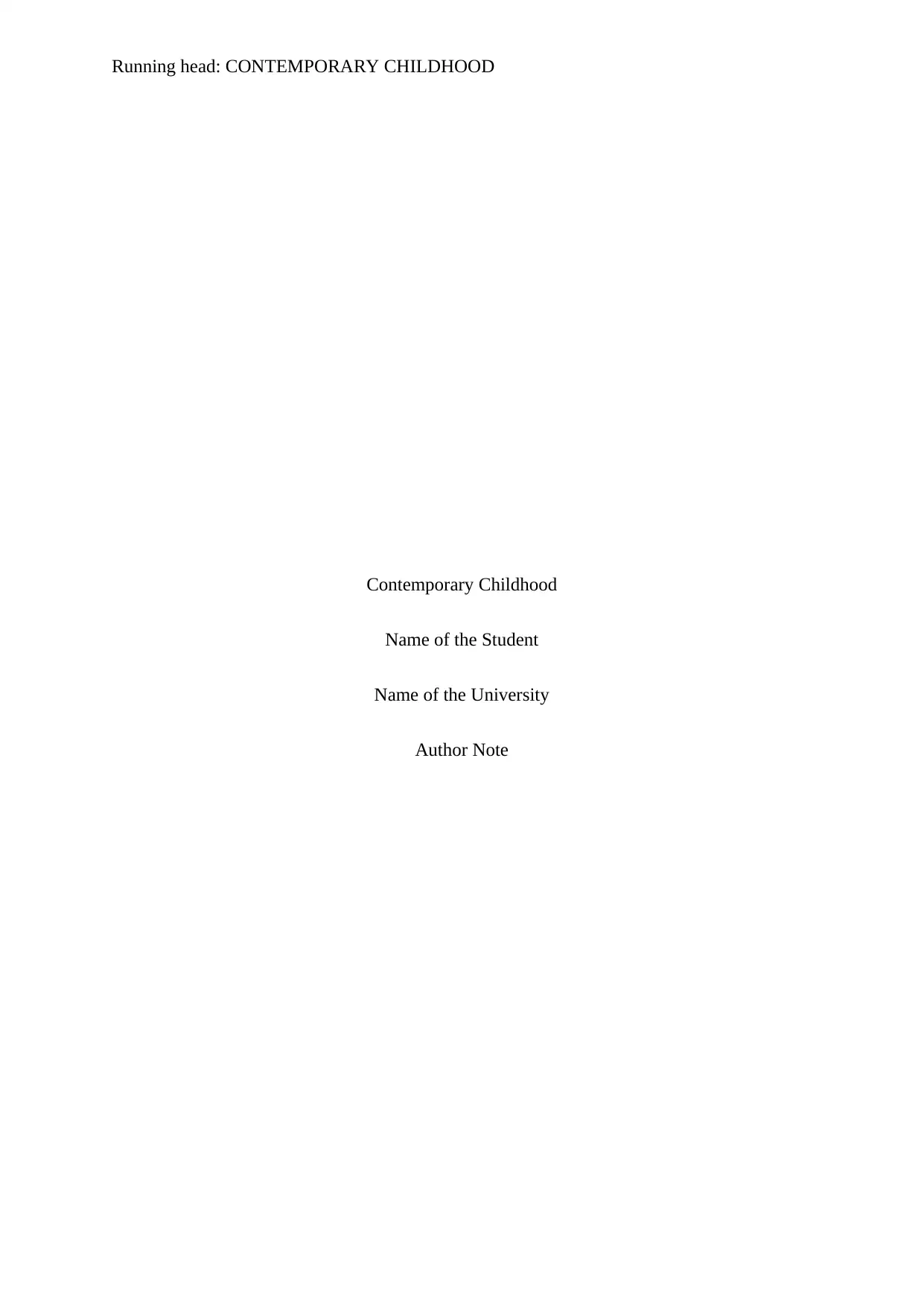
Running head: CONTEMPORARY CHILDHOOD
Contemporary Childhood
Name of the Student
Name of the University
Author Note
Contemporary Childhood
Name of the Student
Name of the University
Author Note
Secure Best Marks with AI Grader
Need help grading? Try our AI Grader for instant feedback on your assignments.
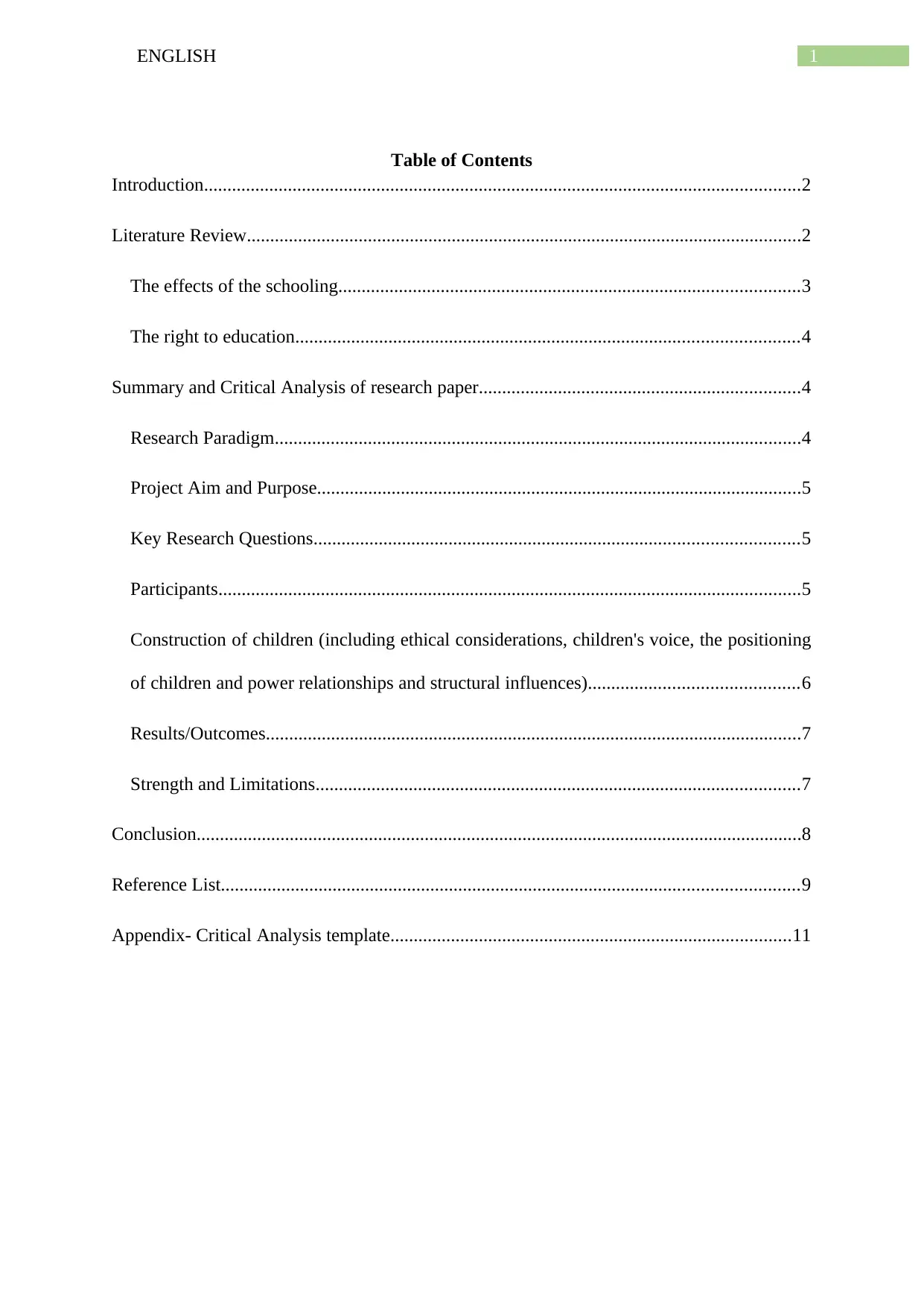
1ENGLISH
Table of Contents
Introduction................................................................................................................................2
Literature Review.......................................................................................................................2
The effects of the schooling...................................................................................................3
The right to education............................................................................................................4
Summary and Critical Analysis of research paper.....................................................................4
Research Paradigm.................................................................................................................4
Project Aim and Purpose........................................................................................................5
Key Research Questions........................................................................................................5
Participants.............................................................................................................................5
Construction of children (including ethical considerations, children's voice, the positioning
of children and power relationships and structural influences).............................................6
Results/Outcomes...................................................................................................................7
Strength and Limitations........................................................................................................7
Conclusion..................................................................................................................................8
Reference List............................................................................................................................9
Appendix- Critical Analysis template......................................................................................11
Table of Contents
Introduction................................................................................................................................2
Literature Review.......................................................................................................................2
The effects of the schooling...................................................................................................3
The right to education............................................................................................................4
Summary and Critical Analysis of research paper.....................................................................4
Research Paradigm.................................................................................................................4
Project Aim and Purpose........................................................................................................5
Key Research Questions........................................................................................................5
Participants.............................................................................................................................5
Construction of children (including ethical considerations, children's voice, the positioning
of children and power relationships and structural influences).............................................6
Results/Outcomes...................................................................................................................7
Strength and Limitations........................................................................................................7
Conclusion..................................................................................................................................8
Reference List............................................................................................................................9
Appendix- Critical Analysis template......................................................................................11
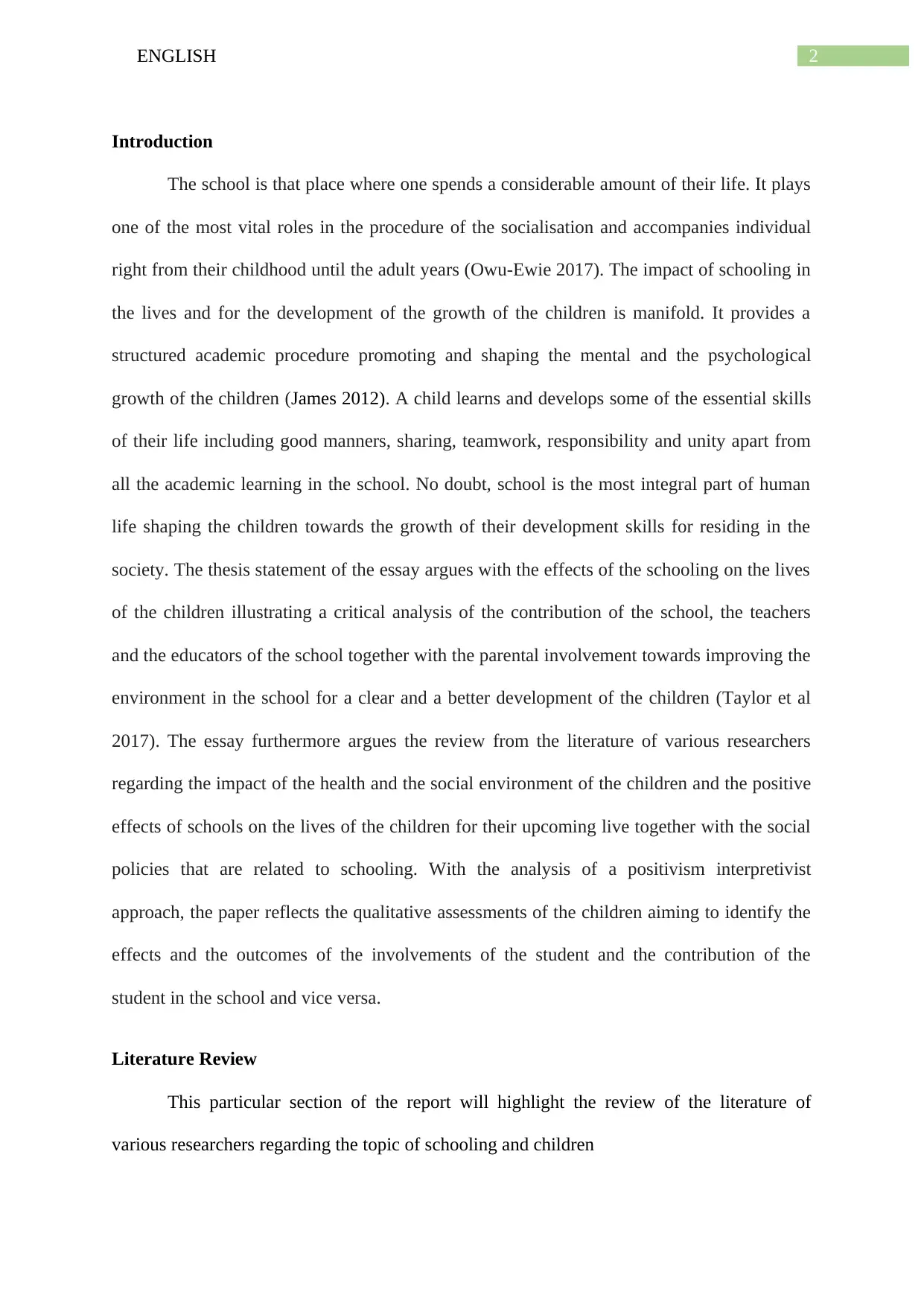
2ENGLISH
Introduction
The school is that place where one spends a considerable amount of their life. It plays
one of the most vital roles in the procedure of the socialisation and accompanies individual
right from their childhood until the adult years (Owu-Ewie 2017). The impact of schooling in
the lives and for the development of the growth of the children is manifold. It provides a
structured academic procedure promoting and shaping the mental and the psychological
growth of the children (James 2012). A child learns and develops some of the essential skills
of their life including good manners, sharing, teamwork, responsibility and unity apart from
all the academic learning in the school. No doubt, school is the most integral part of human
life shaping the children towards the growth of their development skills for residing in the
society. The thesis statement of the essay argues with the effects of the schooling on the lives
of the children illustrating a critical analysis of the contribution of the school, the teachers
and the educators of the school together with the parental involvement towards improving the
environment in the school for a clear and a better development of the children (Taylor et al
2017). The essay furthermore argues the review from the literature of various researchers
regarding the impact of the health and the social environment of the children and the positive
effects of schools on the lives of the children for their upcoming live together with the social
policies that are related to schooling. With the analysis of a positivism interpretivist
approach, the paper reflects the qualitative assessments of the children aiming to identify the
effects and the outcomes of the involvements of the student and the contribution of the
student in the school and vice versa.
Literature Review
This particular section of the report will highlight the review of the literature of
various researchers regarding the topic of schooling and children
Introduction
The school is that place where one spends a considerable amount of their life. It plays
one of the most vital roles in the procedure of the socialisation and accompanies individual
right from their childhood until the adult years (Owu-Ewie 2017). The impact of schooling in
the lives and for the development of the growth of the children is manifold. It provides a
structured academic procedure promoting and shaping the mental and the psychological
growth of the children (James 2012). A child learns and develops some of the essential skills
of their life including good manners, sharing, teamwork, responsibility and unity apart from
all the academic learning in the school. No doubt, school is the most integral part of human
life shaping the children towards the growth of their development skills for residing in the
society. The thesis statement of the essay argues with the effects of the schooling on the lives
of the children illustrating a critical analysis of the contribution of the school, the teachers
and the educators of the school together with the parental involvement towards improving the
environment in the school for a clear and a better development of the children (Taylor et al
2017). The essay furthermore argues the review from the literature of various researchers
regarding the impact of the health and the social environment of the children and the positive
effects of schools on the lives of the children for their upcoming live together with the social
policies that are related to schooling. With the analysis of a positivism interpretivist
approach, the paper reflects the qualitative assessments of the children aiming to identify the
effects and the outcomes of the involvements of the student and the contribution of the
student in the school and vice versa.
Literature Review
This particular section of the report will highlight the review of the literature of
various researchers regarding the topic of schooling and children
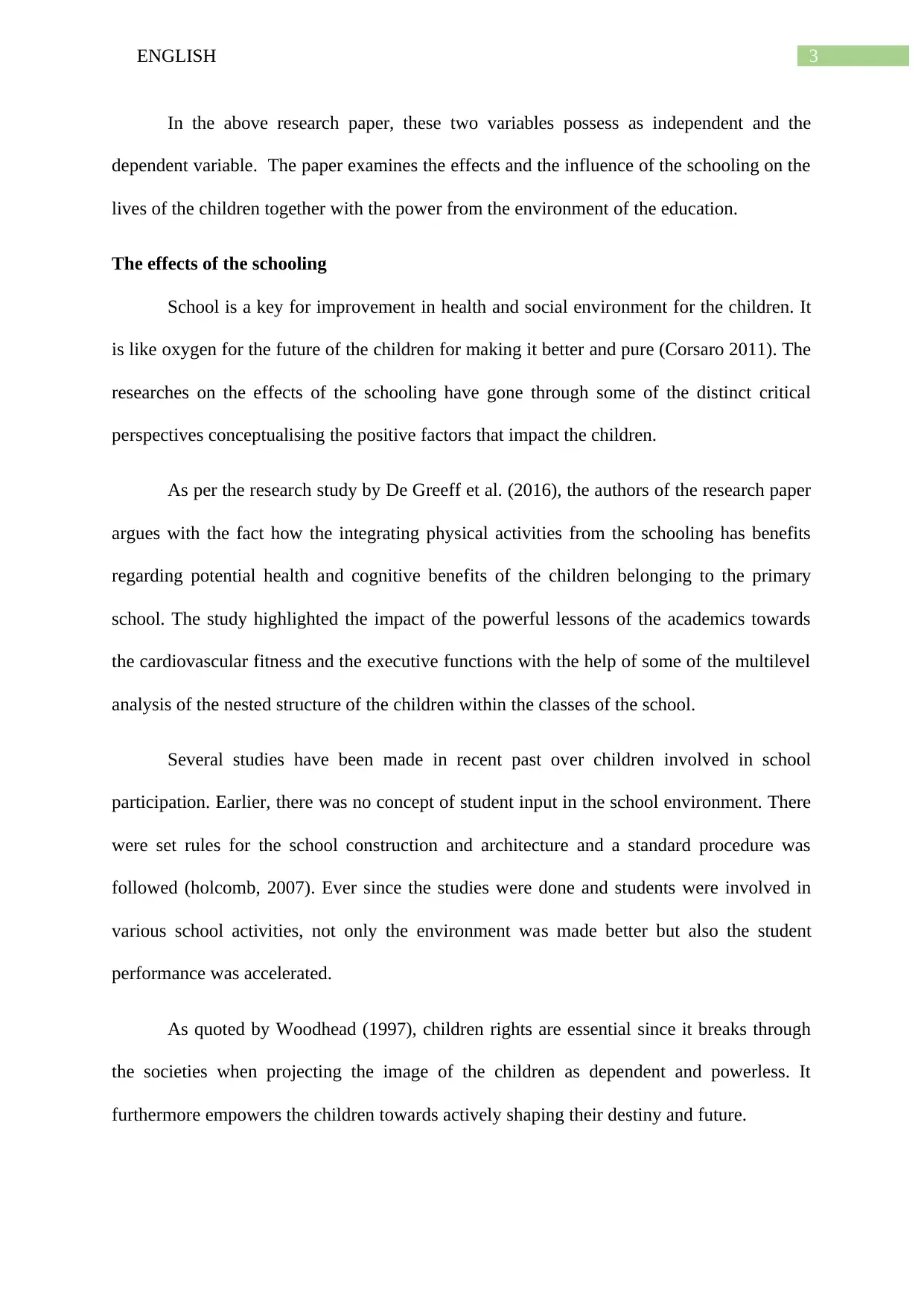
3ENGLISH
In the above research paper, these two variables possess as independent and the
dependent variable. The paper examines the effects and the influence of the schooling on the
lives of the children together with the power from the environment of the education.
The effects of the schooling
School is a key for improvement in health and social environment for the children. It
is like oxygen for the future of the children for making it better and pure (Corsaro 2011). The
researches on the effects of the schooling have gone through some of the distinct critical
perspectives conceptualising the positive factors that impact the children.
As per the research study by De Greeff et al. (2016), the authors of the research paper
argues with the fact how the integrating physical activities from the schooling has benefits
regarding potential health and cognitive benefits of the children belonging to the primary
school. The study highlighted the impact of the powerful lessons of the academics towards
the cardiovascular fitness and the executive functions with the help of some of the multilevel
analysis of the nested structure of the children within the classes of the school.
Several studies have been made in recent past over children involved in school
participation. Earlier, there was no concept of student input in the school environment. There
were set rules for the school construction and architecture and a standard procedure was
followed (holcomb, 2007). Ever since the studies were done and students were involved in
various school activities, not only the environment was made better but also the student
performance was accelerated.
As quoted by Woodhead (1997), children rights are essential since it breaks through
the societies when projecting the image of the children as dependent and powerless. It
furthermore empowers the children towards actively shaping their destiny and future.
In the above research paper, these two variables possess as independent and the
dependent variable. The paper examines the effects and the influence of the schooling on the
lives of the children together with the power from the environment of the education.
The effects of the schooling
School is a key for improvement in health and social environment for the children. It
is like oxygen for the future of the children for making it better and pure (Corsaro 2011). The
researches on the effects of the schooling have gone through some of the distinct critical
perspectives conceptualising the positive factors that impact the children.
As per the research study by De Greeff et al. (2016), the authors of the research paper
argues with the fact how the integrating physical activities from the schooling has benefits
regarding potential health and cognitive benefits of the children belonging to the primary
school. The study highlighted the impact of the powerful lessons of the academics towards
the cardiovascular fitness and the executive functions with the help of some of the multilevel
analysis of the nested structure of the children within the classes of the school.
Several studies have been made in recent past over children involved in school
participation. Earlier, there was no concept of student input in the school environment. There
were set rules for the school construction and architecture and a standard procedure was
followed (holcomb, 2007). Ever since the studies were done and students were involved in
various school activities, not only the environment was made better but also the student
performance was accelerated.
As quoted by Woodhead (1997), children rights are essential since it breaks through
the societies when projecting the image of the children as dependent and powerless. It
furthermore empowers the children towards actively shaping their destiny and future.
Secure Best Marks with AI Grader
Need help grading? Try our AI Grader for instant feedback on your assignments.
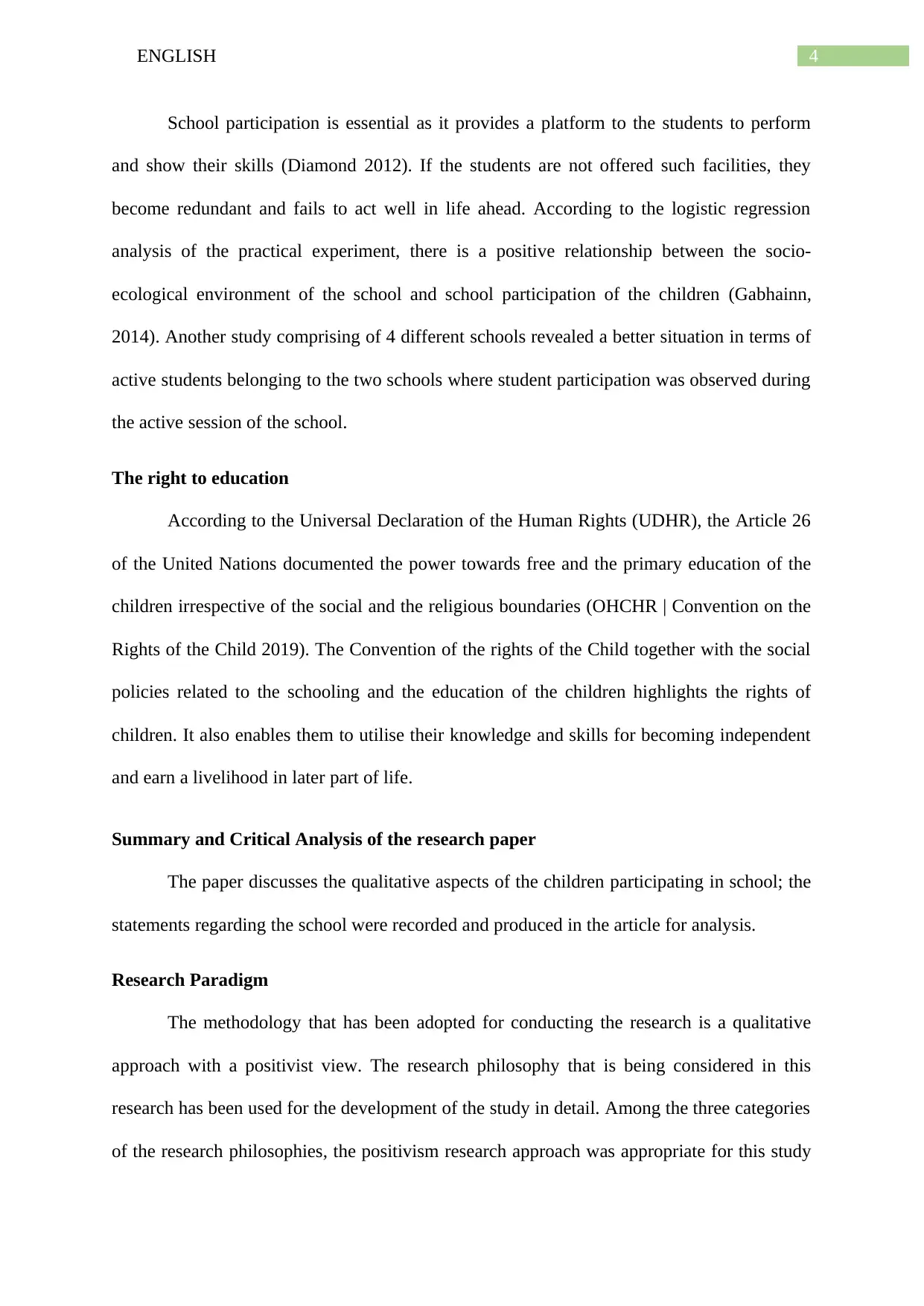
4ENGLISH
School participation is essential as it provides a platform to the students to perform
and show their skills (Diamond 2012). If the students are not offered such facilities, they
become redundant and fails to act well in life ahead. According to the logistic regression
analysis of the practical experiment, there is a positive relationship between the socio-
ecological environment of the school and school participation of the children (Gabhainn,
2014). Another study comprising of 4 different schools revealed a better situation in terms of
active students belonging to the two schools where student participation was observed during
the active session of the school.
The right to education
According to the Universal Declaration of the Human Rights (UDHR), the Article 26
of the United Nations documented the power towards free and the primary education of the
children irrespective of the social and the religious boundaries (OHCHR | Convention on the
Rights of the Child 2019). The Convention of the rights of the Child together with the social
policies related to the schooling and the education of the children highlights the rights of
children. It also enables them to utilise their knowledge and skills for becoming independent
and earn a livelihood in later part of life.
Summary and Critical Analysis of the research paper
The paper discusses the qualitative aspects of the children participating in school; the
statements regarding the school were recorded and produced in the article for analysis.
Research Paradigm
The methodology that has been adopted for conducting the research is a qualitative
approach with a positivist view. The research philosophy that is being considered in this
research has been used for the development of the study in detail. Among the three categories
of the research philosophies, the positivism research approach was appropriate for this study
School participation is essential as it provides a platform to the students to perform
and show their skills (Diamond 2012). If the students are not offered such facilities, they
become redundant and fails to act well in life ahead. According to the logistic regression
analysis of the practical experiment, there is a positive relationship between the socio-
ecological environment of the school and school participation of the children (Gabhainn,
2014). Another study comprising of 4 different schools revealed a better situation in terms of
active students belonging to the two schools where student participation was observed during
the active session of the school.
The right to education
According to the Universal Declaration of the Human Rights (UDHR), the Article 26
of the United Nations documented the power towards free and the primary education of the
children irrespective of the social and the religious boundaries (OHCHR | Convention on the
Rights of the Child 2019). The Convention of the rights of the Child together with the social
policies related to the schooling and the education of the children highlights the rights of
children. It also enables them to utilise their knowledge and skills for becoming independent
and earn a livelihood in later part of life.
Summary and Critical Analysis of the research paper
The paper discusses the qualitative aspects of the children participating in school; the
statements regarding the school were recorded and produced in the article for analysis.
Research Paradigm
The methodology that has been adopted for conducting the research is a qualitative
approach with a positivist view. The research philosophy that is being considered in this
research has been used for the development of the study in detail. Among the three categories
of the research philosophies, the positivism research approach was appropriate for this study
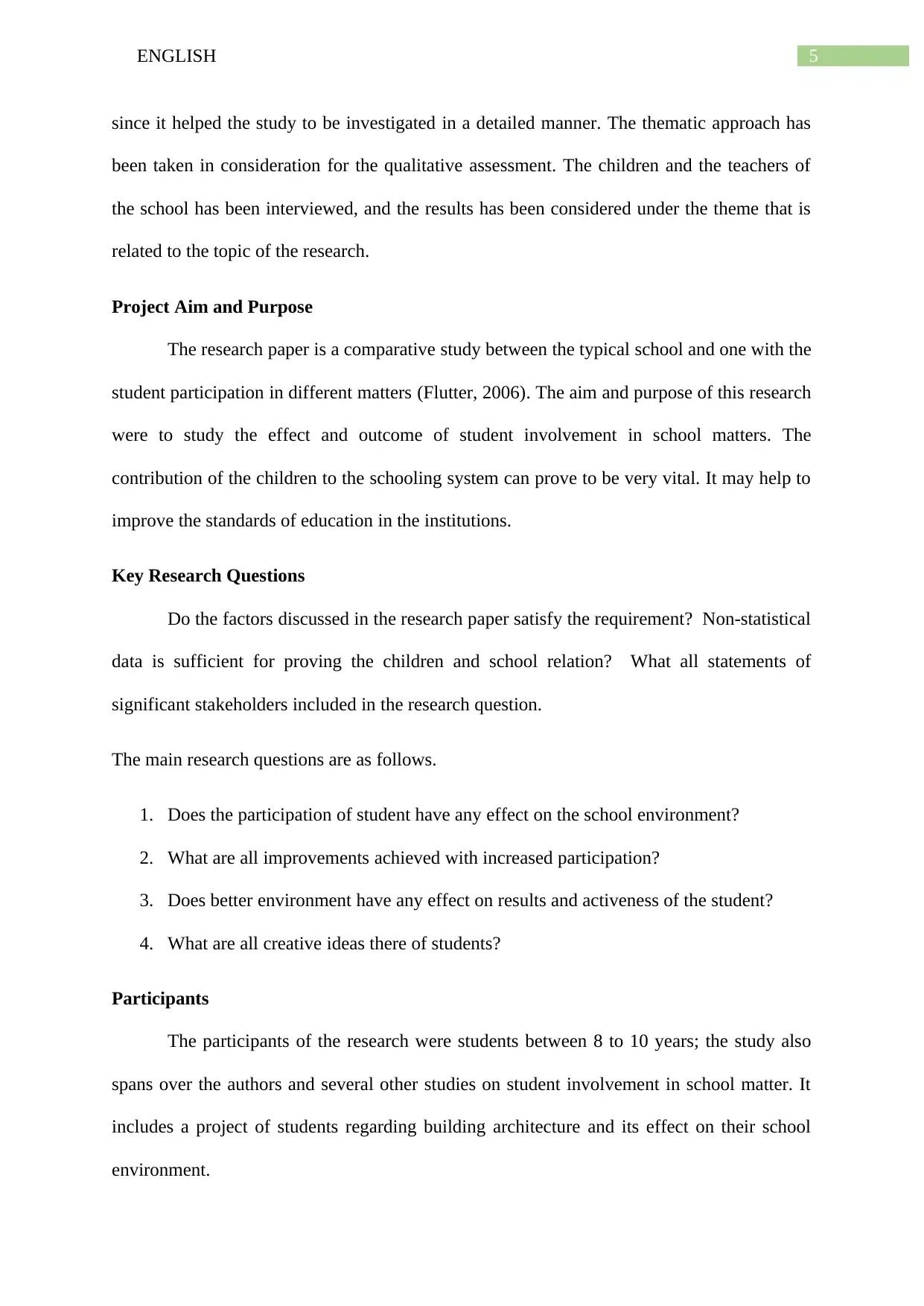
5ENGLISH
since it helped the study to be investigated in a detailed manner. The thematic approach has
been taken in consideration for the qualitative assessment. The children and the teachers of
the school has been interviewed, and the results has been considered under the theme that is
related to the topic of the research.
Project Aim and Purpose
The research paper is a comparative study between the typical school and one with the
student participation in different matters (Flutter, 2006). The aim and purpose of this research
were to study the effect and outcome of student involvement in school matters. The
contribution of the children to the schooling system can prove to be very vital. It may help to
improve the standards of education in the institutions.
Key Research Questions
Do the factors discussed in the research paper satisfy the requirement? Non-statistical
data is sufficient for proving the children and school relation? What all statements of
significant stakeholders included in the research question.
The main research questions are as follows.
1. Does the participation of student have any effect on the school environment?
2. What are all improvements achieved with increased participation?
3. Does better environment have any effect on results and activeness of the student?
4. What are all creative ideas there of students?
Participants
The participants of the research were students between 8 to 10 years; the study also
spans over the authors and several other studies on student involvement in school matter. It
includes a project of students regarding building architecture and its effect on their school
environment.
since it helped the study to be investigated in a detailed manner. The thematic approach has
been taken in consideration for the qualitative assessment. The children and the teachers of
the school has been interviewed, and the results has been considered under the theme that is
related to the topic of the research.
Project Aim and Purpose
The research paper is a comparative study between the typical school and one with the
student participation in different matters (Flutter, 2006). The aim and purpose of this research
were to study the effect and outcome of student involvement in school matters. The
contribution of the children to the schooling system can prove to be very vital. It may help to
improve the standards of education in the institutions.
Key Research Questions
Do the factors discussed in the research paper satisfy the requirement? Non-statistical
data is sufficient for proving the children and school relation? What all statements of
significant stakeholders included in the research question.
The main research questions are as follows.
1. Does the participation of student have any effect on the school environment?
2. What are all improvements achieved with increased participation?
3. Does better environment have any effect on results and activeness of the student?
4. What are all creative ideas there of students?
Participants
The participants of the research were students between 8 to 10 years; the study also
spans over the authors and several other studies on student involvement in school matter. It
includes a project of students regarding building architecture and its effect on their school
environment.
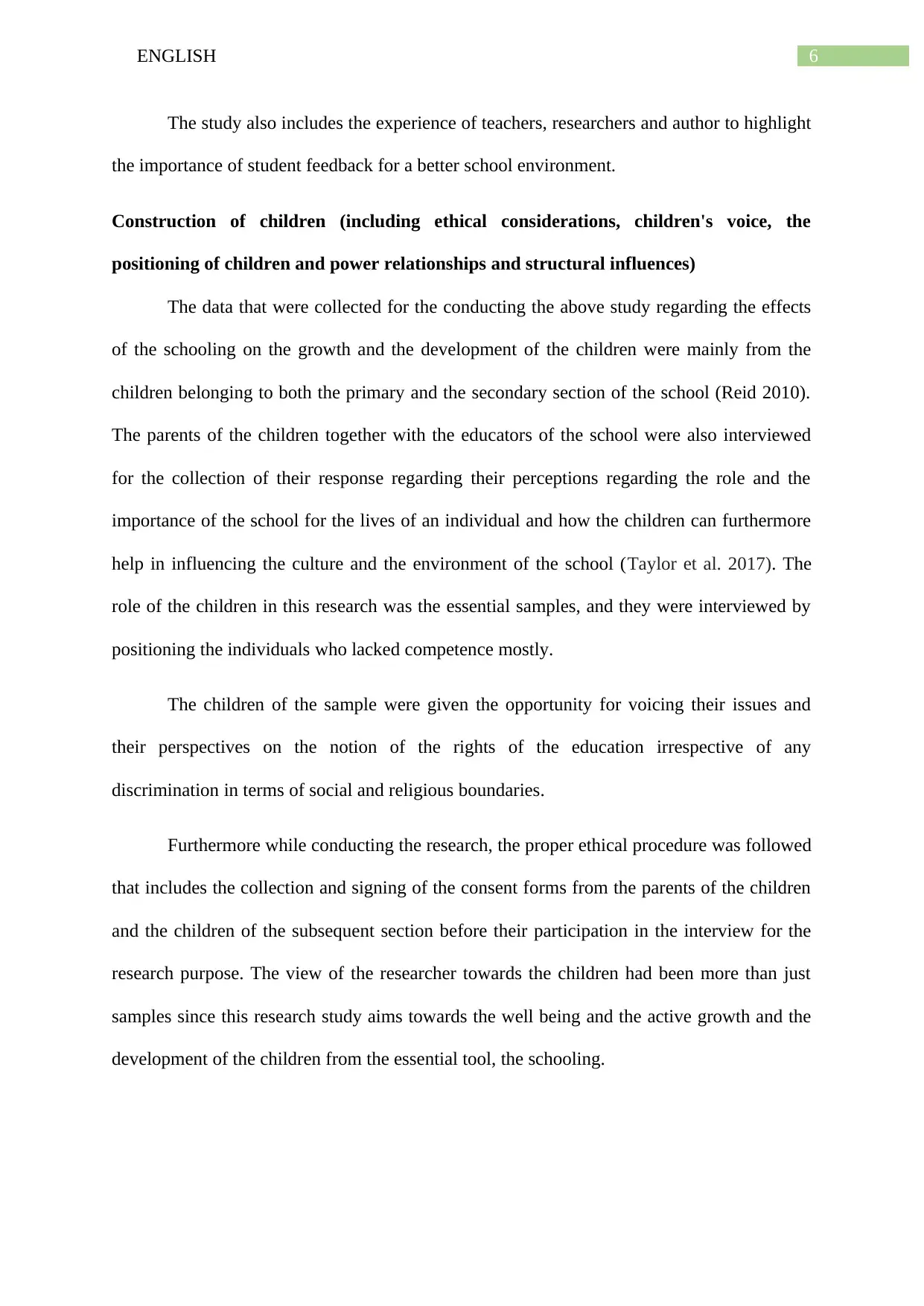
6ENGLISH
The study also includes the experience of teachers, researchers and author to highlight
the importance of student feedback for a better school environment.
Construction of children (including ethical considerations, children's voice, the
positioning of children and power relationships and structural influences)
The data that were collected for the conducting the above study regarding the effects
of the schooling on the growth and the development of the children were mainly from the
children belonging to both the primary and the secondary section of the school (Reid 2010).
The parents of the children together with the educators of the school were also interviewed
for the collection of their response regarding their perceptions regarding the role and the
importance of the school for the lives of an individual and how the children can furthermore
help in influencing the culture and the environment of the school (Taylor et al. 2017). The
role of the children in this research was the essential samples, and they were interviewed by
positioning the individuals who lacked competence mostly.
The children of the sample were given the opportunity for voicing their issues and
their perspectives on the notion of the rights of the education irrespective of any
discrimination in terms of social and religious boundaries.
Furthermore while conducting the research, the proper ethical procedure was followed
that includes the collection and signing of the consent forms from the parents of the children
and the children of the subsequent section before their participation in the interview for the
research purpose. The view of the researcher towards the children had been more than just
samples since this research study aims towards the well being and the active growth and the
development of the children from the essential tool, the schooling.
The study also includes the experience of teachers, researchers and author to highlight
the importance of student feedback for a better school environment.
Construction of children (including ethical considerations, children's voice, the
positioning of children and power relationships and structural influences)
The data that were collected for the conducting the above study regarding the effects
of the schooling on the growth and the development of the children were mainly from the
children belonging to both the primary and the secondary section of the school (Reid 2010).
The parents of the children together with the educators of the school were also interviewed
for the collection of their response regarding their perceptions regarding the role and the
importance of the school for the lives of an individual and how the children can furthermore
help in influencing the culture and the environment of the school (Taylor et al. 2017). The
role of the children in this research was the essential samples, and they were interviewed by
positioning the individuals who lacked competence mostly.
The children of the sample were given the opportunity for voicing their issues and
their perspectives on the notion of the rights of the education irrespective of any
discrimination in terms of social and religious boundaries.
Furthermore while conducting the research, the proper ethical procedure was followed
that includes the collection and signing of the consent forms from the parents of the children
and the children of the subsequent section before their participation in the interview for the
research purpose. The view of the researcher towards the children had been more than just
samples since this research study aims towards the well being and the active growth and the
development of the children from the essential tool, the schooling.
Paraphrase This Document
Need a fresh take? Get an instant paraphrase of this document with our AI Paraphraser
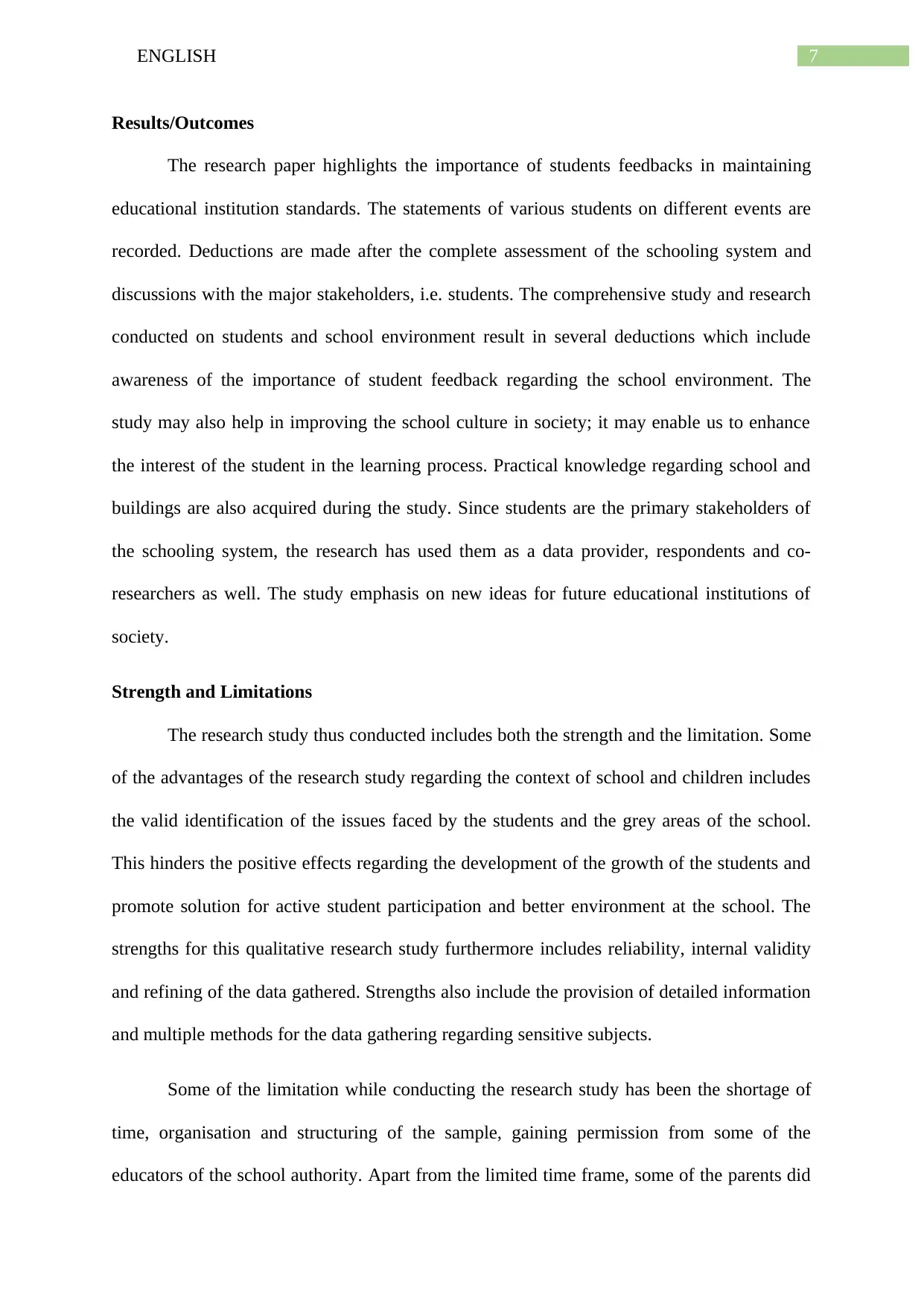
7ENGLISH
Results/Outcomes
The research paper highlights the importance of students feedbacks in maintaining
educational institution standards. The statements of various students on different events are
recorded. Deductions are made after the complete assessment of the schooling system and
discussions with the major stakeholders, i.e. students. The comprehensive study and research
conducted on students and school environment result in several deductions which include
awareness of the importance of student feedback regarding the school environment. The
study may also help in improving the school culture in society; it may enable us to enhance
the interest of the student in the learning process. Practical knowledge regarding school and
buildings are also acquired during the study. Since students are the primary stakeholders of
the schooling system, the research has used them as a data provider, respondents and co-
researchers as well. The study emphasis on new ideas for future educational institutions of
society.
Strength and Limitations
The research study thus conducted includes both the strength and the limitation. Some
of the advantages of the research study regarding the context of school and children includes
the valid identification of the issues faced by the students and the grey areas of the school.
This hinders the positive effects regarding the development of the growth of the students and
promote solution for active student participation and better environment at the school. The
strengths for this qualitative research study furthermore includes reliability, internal validity
and refining of the data gathered. Strengths also include the provision of detailed information
and multiple methods for the data gathering regarding sensitive subjects.
Some of the limitation while conducting the research study has been the shortage of
time, organisation and structuring of the sample, gaining permission from some of the
educators of the school authority. Apart from the limited time frame, some of the parents did
Results/Outcomes
The research paper highlights the importance of students feedbacks in maintaining
educational institution standards. The statements of various students on different events are
recorded. Deductions are made after the complete assessment of the schooling system and
discussions with the major stakeholders, i.e. students. The comprehensive study and research
conducted on students and school environment result in several deductions which include
awareness of the importance of student feedback regarding the school environment. The
study may also help in improving the school culture in society; it may enable us to enhance
the interest of the student in the learning process. Practical knowledge regarding school and
buildings are also acquired during the study. Since students are the primary stakeholders of
the schooling system, the research has used them as a data provider, respondents and co-
researchers as well. The study emphasis on new ideas for future educational institutions of
society.
Strength and Limitations
The research study thus conducted includes both the strength and the limitation. Some
of the advantages of the research study regarding the context of school and children includes
the valid identification of the issues faced by the students and the grey areas of the school.
This hinders the positive effects regarding the development of the growth of the students and
promote solution for active student participation and better environment at the school. The
strengths for this qualitative research study furthermore includes reliability, internal validity
and refining of the data gathered. Strengths also include the provision of detailed information
and multiple methods for the data gathering regarding sensitive subjects.
Some of the limitation while conducting the research study has been the shortage of
time, organisation and structuring of the sample, gaining permission from some of the
educators of the school authority. Apart from the limited time frame, some of the parents did
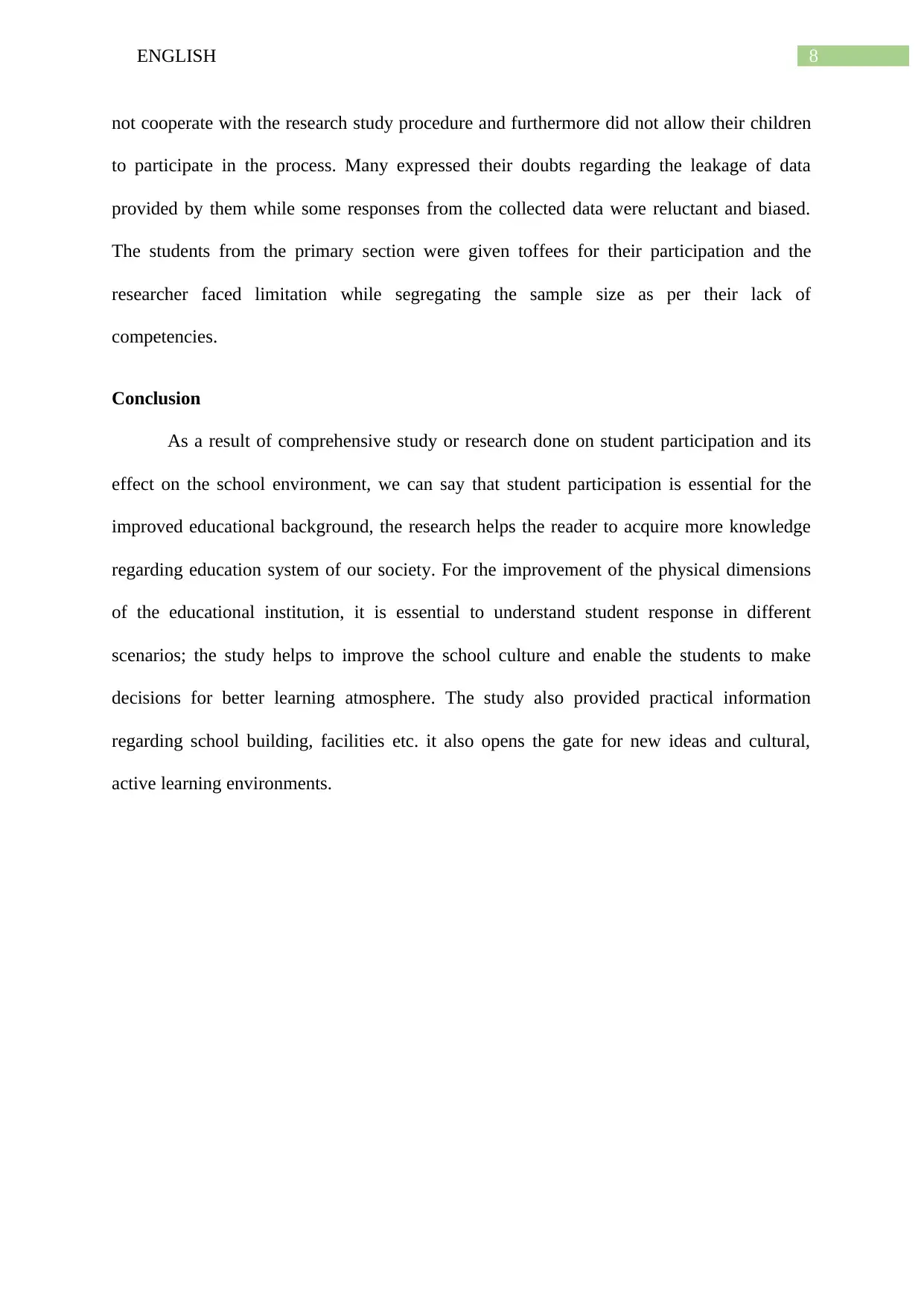
8ENGLISH
not cooperate with the research study procedure and furthermore did not allow their children
to participate in the process. Many expressed their doubts regarding the leakage of data
provided by them while some responses from the collected data were reluctant and biased.
The students from the primary section were given toffees for their participation and the
researcher faced limitation while segregating the sample size as per their lack of
competencies.
Conclusion
As a result of comprehensive study or research done on student participation and its
effect on the school environment, we can say that student participation is essential for the
improved educational background, the research helps the reader to acquire more knowledge
regarding education system of our society. For the improvement of the physical dimensions
of the educational institution, it is essential to understand student response in different
scenarios; the study helps to improve the school culture and enable the students to make
decisions for better learning atmosphere. The study also provided practical information
regarding school building, facilities etc. it also opens the gate for new ideas and cultural,
active learning environments.
not cooperate with the research study procedure and furthermore did not allow their children
to participate in the process. Many expressed their doubts regarding the leakage of data
provided by them while some responses from the collected data were reluctant and biased.
The students from the primary section were given toffees for their participation and the
researcher faced limitation while segregating the sample size as per their lack of
competencies.
Conclusion
As a result of comprehensive study or research done on student participation and its
effect on the school environment, we can say that student participation is essential for the
improved educational background, the research helps the reader to acquire more knowledge
regarding education system of our society. For the improvement of the physical dimensions
of the educational institution, it is essential to understand student response in different
scenarios; the study helps to improve the school culture and enable the students to make
decisions for better learning atmosphere. The study also provided practical information
regarding school building, facilities etc. it also opens the gate for new ideas and cultural,
active learning environments.
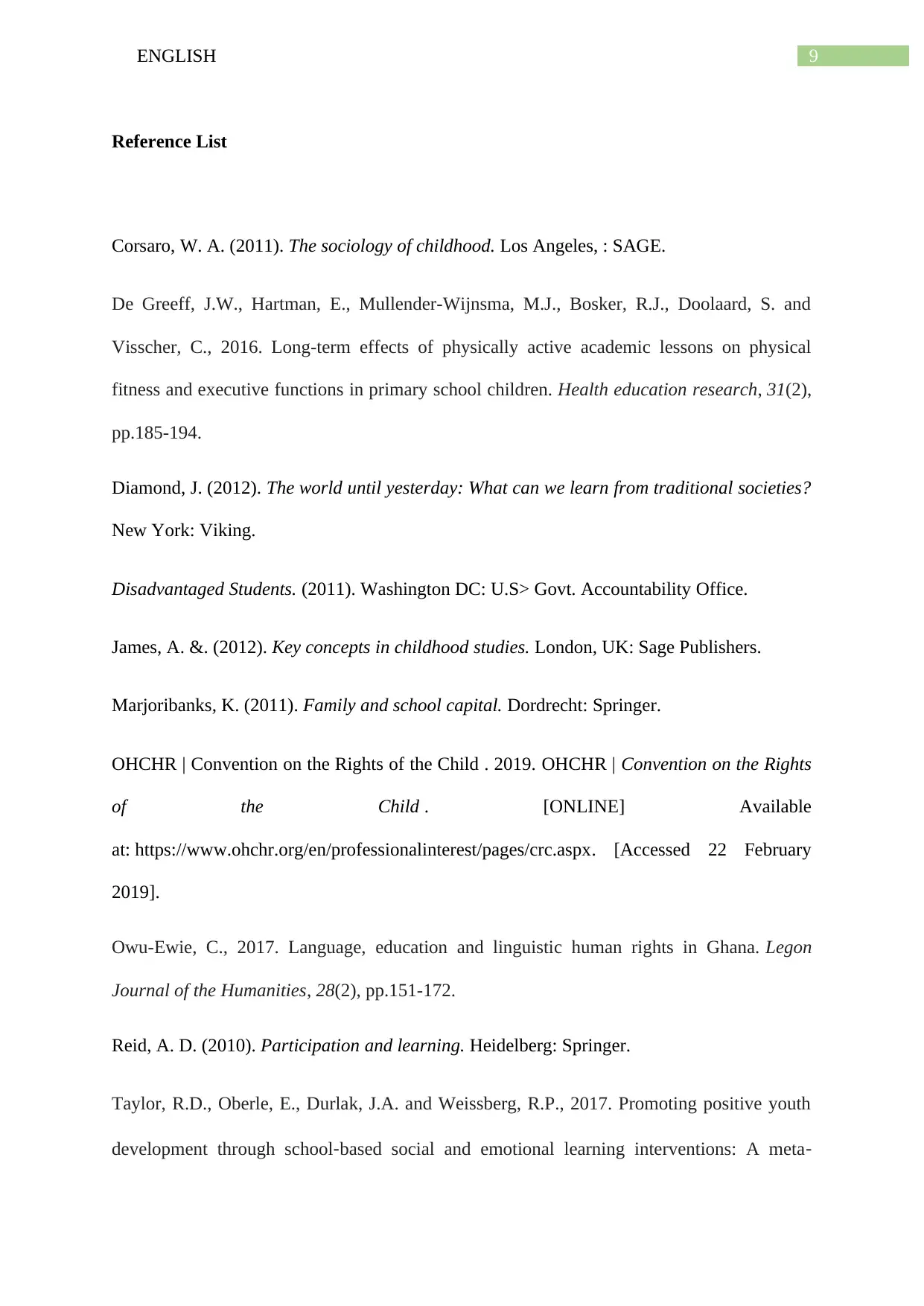
9ENGLISH
Reference List
Corsaro, W. A. (2011). The sociology of childhood. Los Angeles, : SAGE.
De Greeff, J.W., Hartman, E., Mullender-Wijnsma, M.J., Bosker, R.J., Doolaard, S. and
Visscher, C., 2016. Long-term effects of physically active academic lessons on physical
fitness and executive functions in primary school children. Health education research, 31(2),
pp.185-194.
Diamond, J. (2012). The world until yesterday: What can we learn from traditional societies?
New York: Viking.
Disadvantaged Students. (2011). Washington DC: U.S> Govt. Accountability Office.
James, A. &. (2012). Key concepts in childhood studies. London, UK: Sage Publishers.
Marjoribanks, K. (2011). Family and school capital. Dordrecht: Springer.
OHCHR | Convention on the Rights of the Child . 2019. OHCHR | Convention on the Rights
of the Child . [ONLINE] Available
at: https://www.ohchr.org/en/professionalinterest/pages/crc.aspx. [Accessed 22 February
2019].
Owu-Ewie, C., 2017. Language, education and linguistic human rights in Ghana. Legon
Journal of the Humanities, 28(2), pp.151-172.
Reid, A. D. (2010). Participation and learning. Heidelberg: Springer.
Taylor, R.D., Oberle, E., Durlak, J.A. and Weissberg, R.P., 2017. Promoting positive youth
development through school‐based social and emotional learning interventions: A meta‐
Reference List
Corsaro, W. A. (2011). The sociology of childhood. Los Angeles, : SAGE.
De Greeff, J.W., Hartman, E., Mullender-Wijnsma, M.J., Bosker, R.J., Doolaard, S. and
Visscher, C., 2016. Long-term effects of physically active academic lessons on physical
fitness and executive functions in primary school children. Health education research, 31(2),
pp.185-194.
Diamond, J. (2012). The world until yesterday: What can we learn from traditional societies?
New York: Viking.
Disadvantaged Students. (2011). Washington DC: U.S> Govt. Accountability Office.
James, A. &. (2012). Key concepts in childhood studies. London, UK: Sage Publishers.
Marjoribanks, K. (2011). Family and school capital. Dordrecht: Springer.
OHCHR | Convention on the Rights of the Child . 2019. OHCHR | Convention on the Rights
of the Child . [ONLINE] Available
at: https://www.ohchr.org/en/professionalinterest/pages/crc.aspx. [Accessed 22 February
2019].
Owu-Ewie, C., 2017. Language, education and linguistic human rights in Ghana. Legon
Journal of the Humanities, 28(2), pp.151-172.
Reid, A. D. (2010). Participation and learning. Heidelberg: Springer.
Taylor, R.D., Oberle, E., Durlak, J.A. and Weissberg, R.P., 2017. Promoting positive youth
development through school‐based social and emotional learning interventions: A meta‐
Secure Best Marks with AI Grader
Need help grading? Try our AI Grader for instant feedback on your assignments.

10ENGLISH
analysis of follow‐up effects. Child development, 88(4), pp.1156-1171.
Wyness, M. G. (2012). childhood and society. Basingstoke: Basingstoke, UK: Palgrave
MacMillan.
analysis of follow‐up effects. Child development, 88(4), pp.1156-1171.
Wyness, M. G. (2012). childhood and society. Basingstoke: Basingstoke, UK: Palgrave
MacMillan.
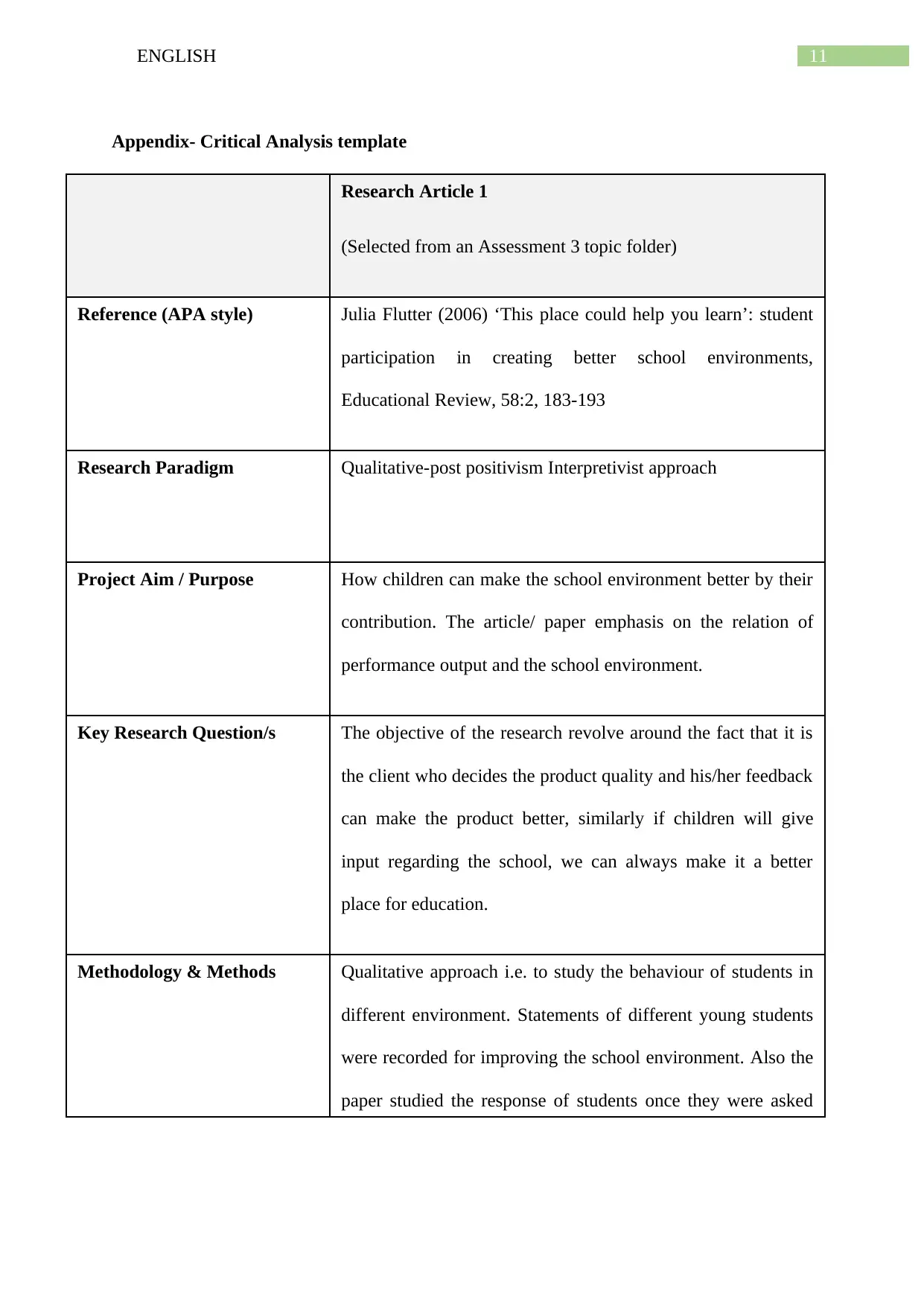
11ENGLISH
Appendix- Critical Analysis template
Research Article 1
(Selected from an Assessment 3 topic folder)
Reference (APA style) Julia Flutter (2006) ‘This place could help you learn’: student
participation in creating better school environments,
Educational Review, 58:2, 183-193
Research Paradigm Qualitative-post positivism Interpretivist approach
Project Aim / Purpose How children can make the school environment better by their
contribution. The article/ paper emphasis on the relation of
performance output and the school environment.
Key Research Question/s The objective of the research revolve around the fact that it is
the client who decides the product quality and his/her feedback
can make the product better, similarly if children will give
input regarding the school, we can always make it a better
place for education.
Methodology & Methods Qualitative approach i.e. to study the behaviour of students in
different environment. Statements of different young students
were recorded for improving the school environment. Also the
paper studied the response of students once they were asked
Appendix- Critical Analysis template
Research Article 1
(Selected from an Assessment 3 topic folder)
Reference (APA style) Julia Flutter (2006) ‘This place could help you learn’: student
participation in creating better school environments,
Educational Review, 58:2, 183-193
Research Paradigm Qualitative-post positivism Interpretivist approach
Project Aim / Purpose How children can make the school environment better by their
contribution. The article/ paper emphasis on the relation of
performance output and the school environment.
Key Research Question/s The objective of the research revolve around the fact that it is
the client who decides the product quality and his/her feedback
can make the product better, similarly if children will give
input regarding the school, we can always make it a better
place for education.
Methodology & Methods Qualitative approach i.e. to study the behaviour of students in
different environment. Statements of different young students
were recorded for improving the school environment. Also the
paper studied the response of students once they were asked
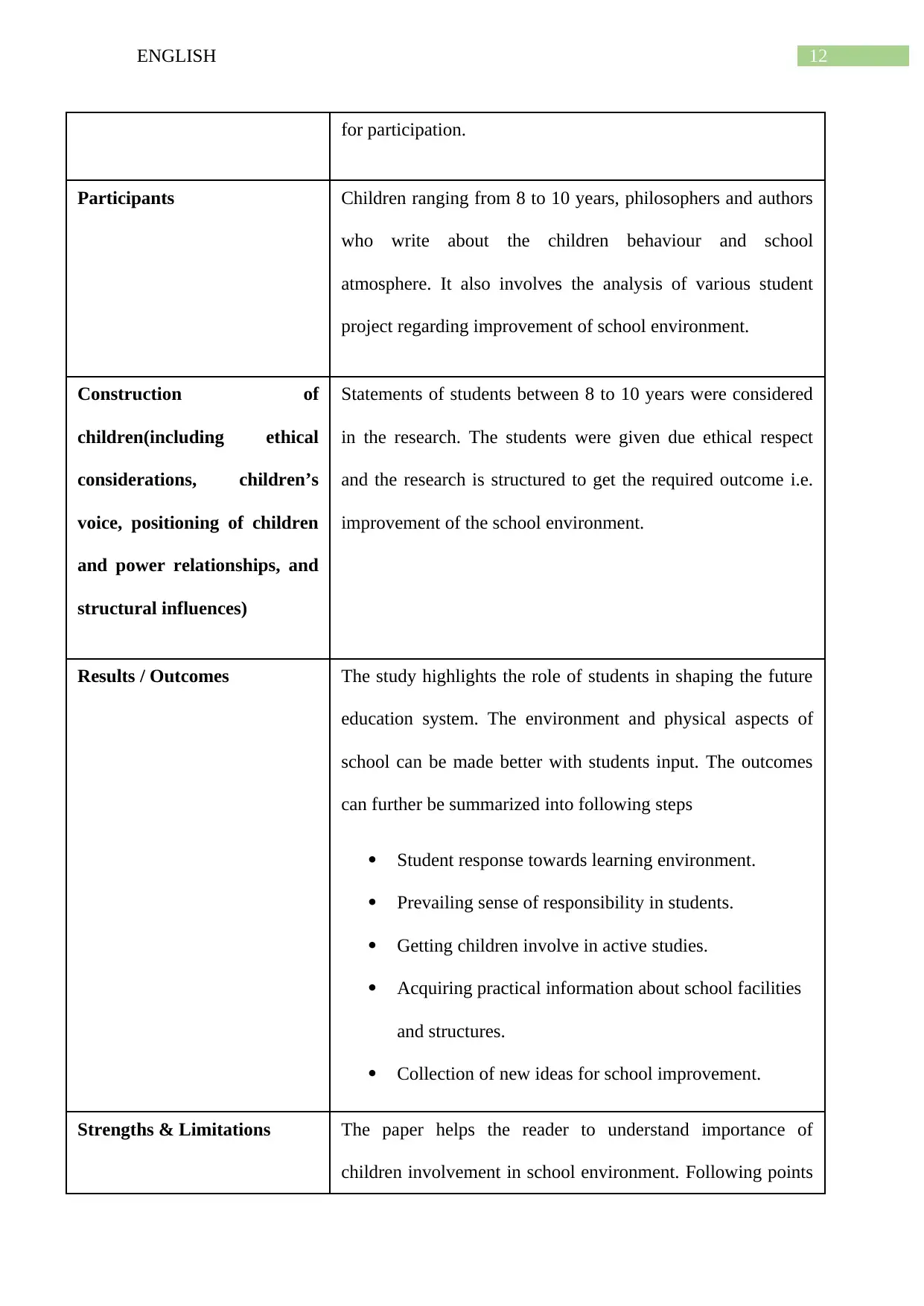
12ENGLISH
for participation.
Participants Children ranging from 8 to 10 years, philosophers and authors
who write about the children behaviour and school
atmosphere. It also involves the analysis of various student
project regarding improvement of school environment.
Construction of
children(including ethical
considerations, children’s
voice, positioning of children
and power relationships, and
structural influences)
Statements of students between 8 to 10 years were considered
in the research. The students were given due ethical respect
and the research is structured to get the required outcome i.e.
improvement of the school environment.
Results / Outcomes The study highlights the role of students in shaping the future
education system. The environment and physical aspects of
school can be made better with students input. The outcomes
can further be summarized into following steps
Student response towards learning environment.
Prevailing sense of responsibility in students.
Getting children involve in active studies.
Acquiring practical information about school facilities
and structures.
Collection of new ideas for school improvement.
Strengths & Limitations The paper helps the reader to understand importance of
children involvement in school environment. Following points
for participation.
Participants Children ranging from 8 to 10 years, philosophers and authors
who write about the children behaviour and school
atmosphere. It also involves the analysis of various student
project regarding improvement of school environment.
Construction of
children(including ethical
considerations, children’s
voice, positioning of children
and power relationships, and
structural influences)
Statements of students between 8 to 10 years were considered
in the research. The students were given due ethical respect
and the research is structured to get the required outcome i.e.
improvement of the school environment.
Results / Outcomes The study highlights the role of students in shaping the future
education system. The environment and physical aspects of
school can be made better with students input. The outcomes
can further be summarized into following steps
Student response towards learning environment.
Prevailing sense of responsibility in students.
Getting children involve in active studies.
Acquiring practical information about school facilities
and structures.
Collection of new ideas for school improvement.
Strengths & Limitations The paper helps the reader to understand importance of
children involvement in school environment. Following points
Paraphrase This Document
Need a fresh take? Get an instant paraphrase of this document with our AI Paraphraser
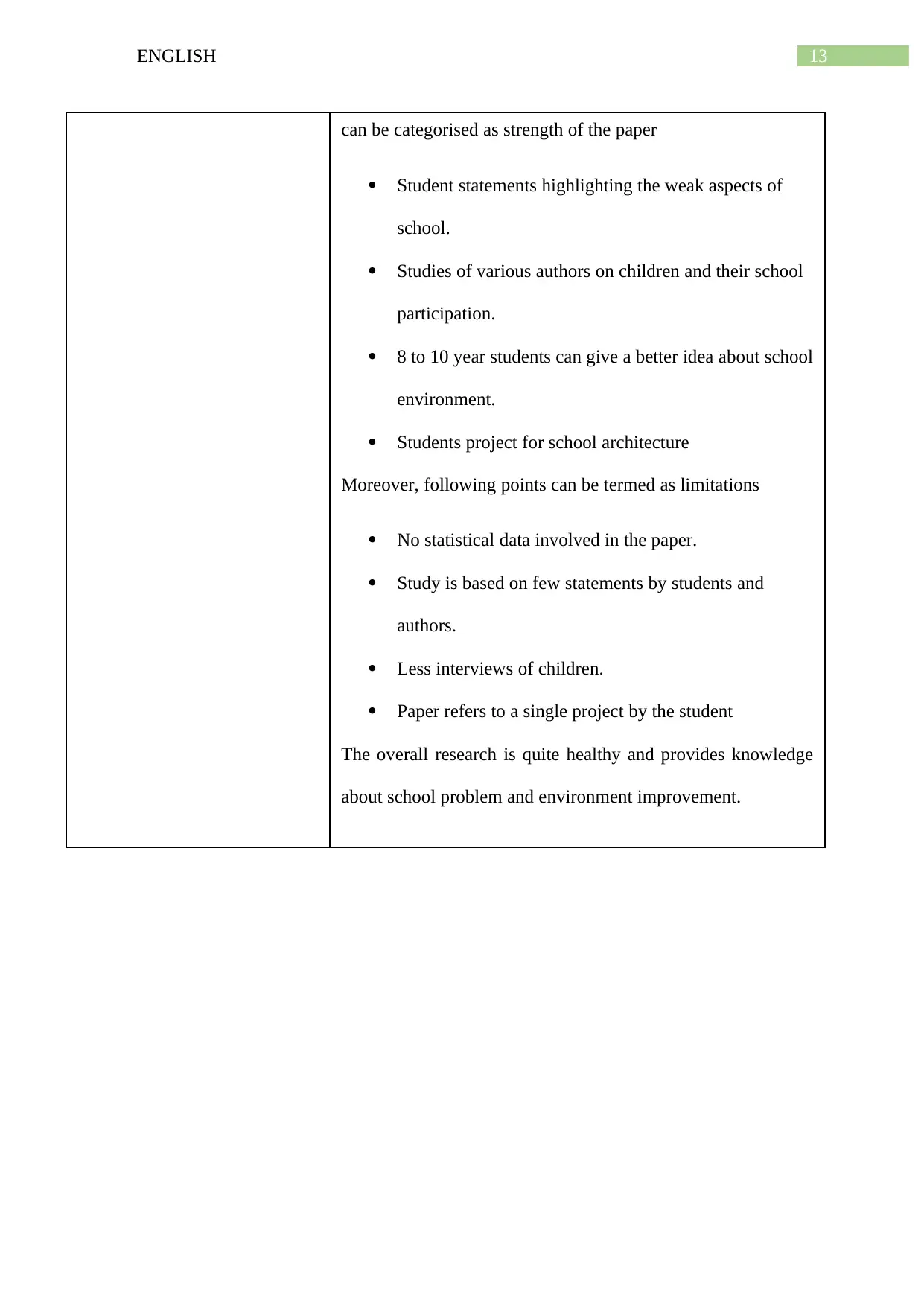
13ENGLISH
can be categorised as strength of the paper
Student statements highlighting the weak aspects of
school.
Studies of various authors on children and their school
participation.
8 to 10 year students can give a better idea about school
environment.
Students project for school architecture
Moreover, following points can be termed as limitations
No statistical data involved in the paper.
Study is based on few statements by students and
authors.
Less interviews of children.
Paper refers to a single project by the student
The overall research is quite healthy and provides knowledge
about school problem and environment improvement.
can be categorised as strength of the paper
Student statements highlighting the weak aspects of
school.
Studies of various authors on children and their school
participation.
8 to 10 year students can give a better idea about school
environment.
Students project for school architecture
Moreover, following points can be termed as limitations
No statistical data involved in the paper.
Study is based on few statements by students and
authors.
Less interviews of children.
Paper refers to a single project by the student
The overall research is quite healthy and provides knowledge
about school problem and environment improvement.
1 out of 14
Related Documents
Your All-in-One AI-Powered Toolkit for Academic Success.
+13062052269
info@desklib.com
Available 24*7 on WhatsApp / Email
![[object Object]](/_next/static/media/star-bottom.7253800d.svg)
Unlock your academic potential
© 2024 | Zucol Services PVT LTD | All rights reserved.





